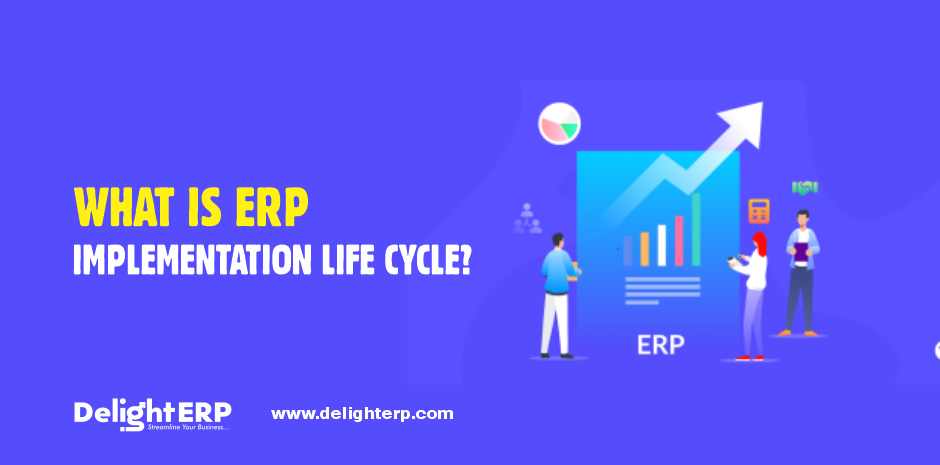Introduction
ERP(Enterprise Resource Planning) is a system that is used by every business or manufacturer. With an Enterprise Resource Planning system, every business can handle all their tasks with only one software.
Businesses or companies have to handle lots of work like accounting, sales tracking, manage customer data, generate reports, etc. To handle all these tasks using different software then it gets complicated.
Businesses or companies easily generate sales reports, employee reports, salary reports, etc. Through these reports, they are easily increasing their sales and increasing profits.
ERP software through businesses or companies can handle all their tasks. They only implement one system to manage all their tasks.
Installation of enterprise resource planning systems to businesses or companies affects too many parts of the business. The implementing process is divided into phases. Businesses have to follow these phases to install the system.
The question which always comes to mind while implementing an ERP system:” How much time does it take to install?”
The answer is simple: it doesn’t take too much time if the business follows the installation step properly then they easily implement the system in a short period.
What Is an ERP Implementation?
Enterprise Resource Planning implementation is a process to install software and make this live-in lifestyle to handle the workflow.
Businesses have many tasks like properly handling their accounts and finances, managing their stocks, managing the customer details, etc. They need a system to handle all these tasks and reduce their workload.
ERP system is easy to handle all the tasks and reduces the burden of the business. Companies easily handle all work using one system instant of using different software. Businesses operate only one software to handle all their work.
Companies follow a few steps for the implementation process. Businesses preferred to use ERP software to handle their workflow. For the successful installation process, businesses have to be clear about their requirements, carefully select the packages and determine their goal before installation.
The implementation process for the ERP system describes the process of planning, design, and deployment. The system is tested before deploying for providing an errorless system to businesses.
Without proper planning, the business didn’t generate success, proper planning provides an opportunity for the companies to reach their goals.
Recommended For You: How ERP Software Is Important For Sales Management
ERP implementation life cycle
Businesses have to follow steps for the implementation life cycle of the ERP system. If the company follows these steps then they successfully install the enterprise resource planning software.
1. Proper Planning
ERP implementation starts with planning. In this step organization planning and research about the system which type they required.
The project team of the company selects a proper system plan. In the market, there are various systems available with different features but select suitable systems for business. Throughout this step, the company is clear about their requirement, and then after proper planning, they jump to the next step.
2. Selection of system
In the market, there are too many companies that offer ERP systems with different features. So after proper planning companies determine their requirements. As per requirement, the company has to find the perfect system to handle their various tasks.
The selection of Enterprise Resources Planning software services is very important for business. Because the company handles their work with the system.
3. GAP Analysis
After selecting a system, the company has to analyze the whole software. Here, the company finds out the gaps between the provided offer features and their own needs.
If the company figured out the ERP software which is 80% up then businesses would find the best system for their organization.
4. Re-engineering
Through this step, developers have to make various changes according to the company’s requirements. To make the process more efficient, the re-engineering process includes several changes based on GAP analysis.
5. Employees Training
A company or organization installed the system but didn’t know about how to operate the system then it will be worthless. Employee training is part of the implementation.
If there is any new system then, they need the training to use the software. After install of the ERP software, the company learns about operating the software and how to use the software.
6. Testing
This is another important step of the implementation. This is a step that needs to be followed because through this step the developer knows about the weakness of the system. So, this will be beneficial for the business while they live their system.
There are various types of systems testing like unit testing, integration testing, security testing, performance testing, and stress testing.
7. Deployment
Once all the testing and planning are completed then the next step is where the business lives in their system. The project team is prepared themselves to give all answers to the user questions and solve the query regarding the system.
Here, companies install new systems to manage their work or some companies reinstall updated systems.
8. Support & Updates
The last steps of the implementation. After installing the system, developers stay connected with users and solve their issues regarding the software. Developers also adjust the system according to the users and make them happy.
Developers offer the updates of ERP systems with the new technology for better selling processes of the company.
How to select ERP packages?
Manufacturers have to manage various tasks like accounting management, sales management, Finances management, etc. Through ERP system manufactures easily manage all the work or tasks with the help of the one software.
When businesses select the ERP software then they have to be clear about their goal and requirements. The company easily maintained all their work and with the ERP software, they reduced their workloads.
-
Accounting management
At the time of selecting a software company selects the software which provides the accounting management features included with the other features.
Accounting management is important for companies or businesses, through accounts companies easily know about their profits, and a well-maintained account balance sheet attracts the financers. When selecting the ERP system, clarify that accounting management features are included with the other features or services.
-
Generate reports
The report is most important to know about sales ratio and new customers. Companies sell their products in the whole year and they make several new customers. So, keeping a record of sales is important for companies or businesses.
Companies or businesses have to find a system that has features to generate the report automatically regarding the sales, customer, past selling, stock report, etc.
-
Inventory management
Inventory management keeps supply networks functioning smoothly. With inventory management, the customer puts their trust easily in the company. Because through inventory management products reach their destination on time.
ERP system has a feature for managing inventory then companies get success on their sales. With better inventory management businesses gain customer trust.
-
Manage various operations
Businesses or manufacturers are not only handling only one task or work, they have multiple tasks to do. So, while selecting the ERP system company has to analyze the system for handling the multi-tasks.
Businesses or companies select the enterprise resources planning system through which they easily handle all their tasks or works.
Businesses, companies, or manufacturers carefully select the ERP system for their use. With the proper ERP software companies well-maintained their whole process.
Also Read: Steps To A Successful ERP Implementation
Conclusion
The ERP system is important but the ERP implementation life cycle is also important for business. There are few steps to implement the system like planning, gap analysis, re-engineering, training, testing, deployment, and support.
For a successful implementation, companies have to follow their steps and be clear about their requirements to reduce their workload. If the company grows in the competitive market they have to manage their work quickly and the company handles their work with an ERP system.





